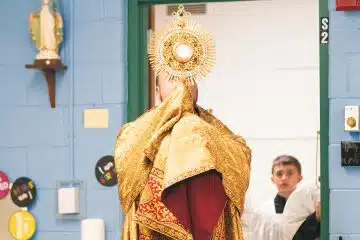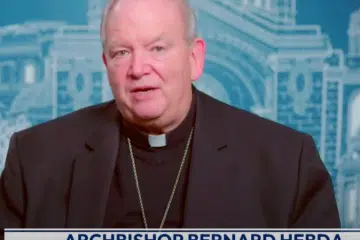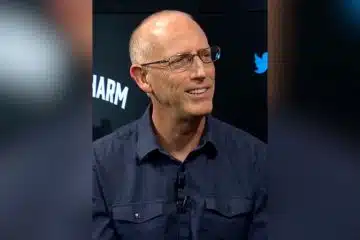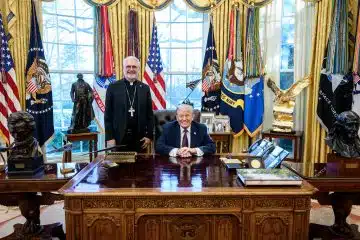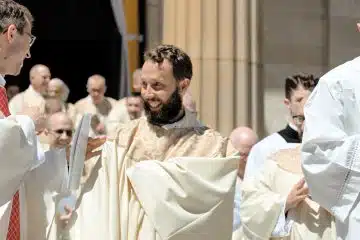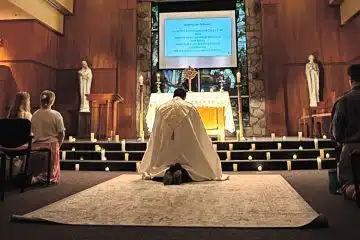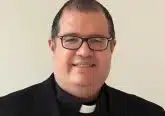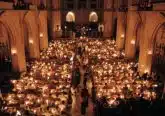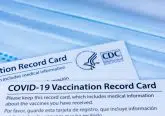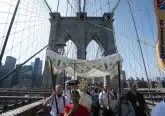Brooklyn bishop: ‘Outrageous’ NY coronavirus restrictions ignore church successes
CNA Staff, Oct 7, 2020 / 04:33 pm MT (CNA).- The Bishop of Brooklyn has strongly criticized the re-imposition of strict coronavirus rules on places of worship in New York City-area hot zones, saying Catholic churches have worked hard to prevent coronavirus spread and Catholics deserve access to their churches.
“It is outrageous that after incurring great expense to implement all the safety protocols, our parishes are being forced to reduce capacity to a maximum of 10 people in the red zone and 25 people in the orange zone,” Bishop Nicholas DiMarzio of Brooklyn said Oct. 5, using the color codes for the restriction categories.
“To think that some of our churches have the capacity to hold a thousand people for Mass, a capacity range of 10 to 25 people is disrespectful to Catholics and to the clergy who all have followed the rules and, as such, have prevented a spike in Covid cases within the confines of the hot zones,” he said, adding, “The safety of parishioners is paramount for the Diocese of Brooklyn, but the religious freedom of our parishioners is being unjustly attacked. The facts show that Catholic churches in Brooklyn and Queens are safe and have followed all safety guidelines.”
The new restrictions have three sets of rules for gatherings based on severity of coronavirus spread. The color-coded zones are labeled, in order of severity, red, orange, and yellow.
In a red zone, houses of worship gatherings are limited to 25% capacity or 10 people maximum. In a yellow zone, they are limited to 50% capacity. Neither schools nor businesses deemed non-essential will be allowed to operate in a red zone.
DiMarzo made the case that Catholic churches have taken all reasonable precautions and have a record of safety.
“Catholic Churches in Brooklyn and Queens have not had any COVID outbreaks or significant cases since re-opening on July 5th to 25% capacity. We fervently object to being told to further reduce capacity, because we have strictly adhered to COVID-19 protocols, and the safety measures have been working,” he said.
“Our congregants have fully cooperated with the mask requirement and have been sitting six feet apart with a row in between,” the bishop said. “Catholic churches in the Diocese of Brooklyn are regularly sanitized, and hand sanitizers are set up at all entrances. Former New York City Office of Emergency Management Commissioner Joseph Esposito guided us on our Reopening Plans and the subsequent safe re-opening of our churches.”
Esposito told the diocesan newspaper The Tablet he was also critical of the new rules.
“It’s ridiculous. It absolutely makes no sense,” he said.
Esposito’s committee guided the diocese’s rules to limit church seating to 25%, mandate face masks use, and adhere to social distancing protocols.
“We go out of our way to make sure it is safe. The churches have been doing the right thing. We are being punished for our hard work,” Esposito told The Tablet. “And why this is being done by ZIP code makes no sense. What if you live in one neighborhood and go to church in another?”
There are some 1.5 million Roman Catholics and 210 Roman Catholic churches in Brooklyn and Queens.
The disease arrived especially hard in New York, which has seen 32,000 fatalities and peaked at more than 1,000 deaths per day in early April. Nationwide, about 7.5 million people have been infected, with 210,000 dead.
While most people who contract the coronavirus do not require hospitalization, it can pose significant risks for the elderly or those with underlying health conditions.
New York Gov. Andrew Cuomo said the stricter rules were necessary to contain outbreaks. He said that failure to enforce existing laws had led to the renewed spike. He blamed localities for not enforcing social distancing rules and mask mandates.
“If you do not agree to follow the rules, then we will close the institutions down. I am prepared to do that,” he said at an Oct. 6 news conference.
“This is about mass gatherings,” he said. “And one of the prime places of mass gatherings are houses of worship.”
“A mass gathering causes infections, infections cause a cluster, a cluster causes community spread, Cuomo added. “That is the natural evolution of things unless we intervene and we stop the cycle.”
The resumption of restrictions on houses of worship was a surprise to religious leaders, the New York Times reports.
“All of this seems very poorly executed, the decision and the communication, all of it,” Rabbi Motti Seligson, a spokesman for the Brooklyn-based Chabad-Lubavitch Hasidic movement, told the New York Times.
Religious leaders said they were not consulted about the measures, which take effect Oct. 9; at sunset that day the Jewish holiday Shemini Atzeret begins.
Recent coronavirus outbreaks have taken place in Brooklyn, Queens, and the northern suburbs of New York City, and some of these areas have large Orthodox Jewish populations.
Cuomo has specifically used photos of packed crowds of Orthodox Jews to argue for the restrictions.
A group of four Orthodox Jewish lawmakers accused the governor of “irresponsible and pejorative rhetoric,” including using a photograph of Jews from more than 10 years ago during his news conference. They accused the governor of lying about the scope of the lockdown measures during a conference call, saying he had engaged in “a duplicitous bait-and-switch.”
Hundreds of Hasidic men gathered in protest after midnight early Oct. 7 in the Borough Park neighborhood, the New York Times reports. Most of them rejected masks and set fires along the street. At least one man was swarmed by a mob which accused him of disloyalty to the community.
New York state’s first cluster of infections took place in March at a synagogue in New Rochelle, where dozens of members became infected. In recent months some Orthodox synagogues have been venues for large gatherings of people who do not take precautions against the virus.
Father William With, pastor of Resurrection Church in the Gerritsen Beach neighborhood, told The Tablet that sacramental celebrations are “so important” and “it is essential that we stay open.” Parishioners are only “just starting to come back,” he added.
“We have not fully recovered. They are coming back slowly but surely. It would be a bad sign for our people if we had to close now,” Fr. With said.
Schools in parts of Rockland and Orange counties will close under the rules. On Oct. 5 Cuomo ordered schools in nine zip codes of Brooklyn and Queens to close. Although these zip codes represent 7% of New York City’s population, they have accounted for more than 20% of new coronavirus infections in the last four weeks.
Catholics schools in the Diocese of Brooklyn have asked Cuomo to permit its four schools in the areas to continue in-person learning. With a combined enrollment of over 1,000 students, they have had one confirmed case of Covid-19.
Tom Chadzutko, superintendent of schools for the Brooklyn diocese, said Oct. 5 that the governor’s action “clearly fails to take into account the positive progress our Diocesan school system has made so far this school year.”
“It is unconscionable to think that after the many sacrifices our staff, students, and parents have made, and in spite of our almost non-existent infection rate, the governor has decided to force our four schools to close,” he said.
Some churches and other religious organizations have pursued legal action against coronavirus restrictions they say wrongly single out religious gatherings for strict treatment, compared to other gatherings or venues of similar size.
In June New York Mayor Bill de Blasio drew criticism for saying protests against racism and police brutality were essential, but religious services were not.



